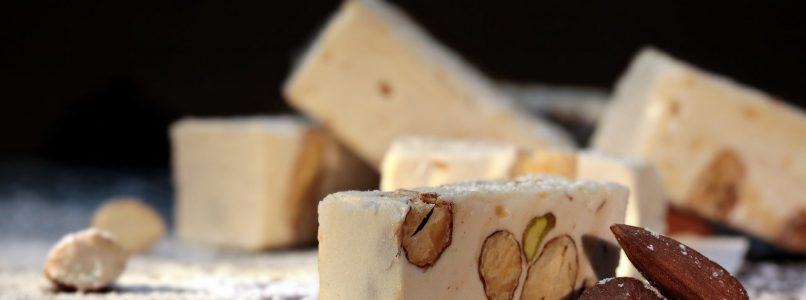What an adventurous crossroads of stories allowed us to savor that authentic Christmas delight that is nougat! A dessert that is well rooted throughout Italy thanks to the fact that over the centuries the traditions of different countries and peoples have arrived in our country, united by the ability to create sweets from honey, egg whites and dried fruit. If, therefore, today the Italian nougat is considered excellent and its production is rooted from Lombardy to Sicily, from Piedmont to Campania, from Veneto to Calabria, it is also due to the ancient French, Spanish, Arab and Oriental influences combined with the enhancement of local raw materials, such as Piedmontese hazelnuts or Sicilian almonds. This is why there is not just one nougat but dozens of different recipes, all to be discovered. For the pleasure of gourmands.
Many types, many recipes
The fact that dozens of different types of nougat are produced in Italy alone makes it impossible to code the recipe. And this explains why on the market you can find products on sale that are so different from each other, all labeled as "nougat". What they have in common are the production process and the basic recipe, consisting of sugar and honey (especially wildflower), mixed with whipped egg white. There diversity lies in the additional ingredients used (from dried figs to chocolate, from almonds to candied fruit) but also in the shape and type of pasta, as well as in the possible addition of additives, not provided for in traditional recipes.
Despite its long tradition, the Italian nougat has few protections. The name "nougat" is not codified and among the products protected in the EU there is only one IGP nougat, that of Bagnara (while in Spain, for example, there are two). A "hole" that some local authorities have tried to remedy: for example, the recipe of the one from Cremona is guaranteed by Deco, the municipal name, which establishes the use of fine ingredients (such as Italian almonds and local honey) present in precise quantities (for example, at least 36% of almonds).
Artisan and industrial compared
Artisan and industrial nougat are different but, if well made, they are both quality products. The production process is the same, developed over the centuries, but the artisan nougat has a longer preparation, especially as regards cooking. If the industrial one is cooked under vacuum at over 100 ° C temperature for a maximum of four hours, the artisan one remains a slow product: to do it well it takes time and the artisan producers take it all (up to 11 hours and no more than 70 ° C ), rejecting "shortcuts", such as jellies or glucose, which would make production easier and faster, or the addition of additives and flavors, to improve the organoleptic characteristics of the nougat.
How to recognize a quality nougat
Pay attention to the ingredients, which must be few and with nuts or honey in the first place. Better that there are no additives (such as flavorings or preservatives) or gelatine of animal origin. As for the consistency, the soft nougat must not turn out to be rubbery (a sign that it contains gelling agents and thickeners and few noble ingredients), while the hard one must break with a clear fracture, without crumbling.
Whether it is hard or tender, it does not matter: the important thing is that, once bitten, it immediately melts in the mouth, without sticking to the teeth and leaving the mouth pleasantly clean. It is also important that the sweetness is not excessive and does not cover any other sensation and that the taste is rich and harmonious, with evident notes of dried fruit and honey.
Two traditional "made in Italy" specialties to try
To make a "closed box" purchase you can choose the Bagnara Calabra nougat, the only one in Italy to have obtained the Protected Geographical Indication (PGI). This long-standing nougat has a codified recipe, and unique both for its ingredients (toasted but not peeled Sicilian almonds, citrus honey and sugar with the addition of bitter cocoa, essential oils and powdered spices) and for the production technique (cooks over direct heat at 180-200 ° C for up to six hours). The result is a brown nougat with a rippled surface (in fact it is called "a monk's mantle"), with a glassy consistency reminiscent of amber, and a crumbly and crunchy paste, with many well-distributed almonds. On the palate it is exquisite and balanced, because the sweetness of the toasted almonds is balanced by the sensation of mulled wine and the light spicy aftertaste.
Another specialty to try is the nougat of Tonara, famous for centuries and not only in Sardinia. In fact, Tonara is considered the country of itinerant nougat makers, who produced nougat at home, cooking it over a live fire, and then went to sell it at village festivals. Today about fifty remain in business, which continue to bring their product throughout Sardinia. To send Tonara nougat around Italy and the world are instead four companies that produce it in modern laboratories but always respecting the traditional classic recipe. Its peculiarity is that it is prepared with only three ingredients: egg white, dried fruit (which alone accounts for half its weight) and Barbagia honey. You can clearly feel it when you taste it: the honey gives it an intense aroma, the high content of dried fruit a balanced and not cloying sweetness, while the egg white gives it a semi-soft and elastic texture.
December 2021
Manuela Soressi
This recipe has already been read 453 times!
